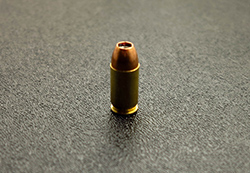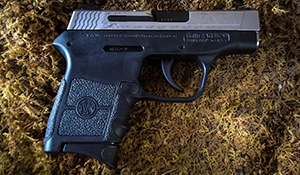It takes a pretty self-assured shooter to admit to other gun folks that they carry a 380. It has been long held as a truth that the 380 ACP is just too small and underpowered to be useful as a self-defense round. But is it?
380 for self Defense? The diminutive 380 ACP certainly has it’s detractors. But coupled with modern defensive bullet-design and new light handguns the 380 may deserve another look.
After keying that last sentence in I felt a quake in the force. At the risk of my credibility, I am going to continue with this post. Let’s take an unvarnished look at the 380 ACP. The good, the bad the truth and the fable.
The Stats on 380

- Bullet Length .984 inch
- Bullet diameter .355 inch (this is 9 mm)
- Maximum pressure 21,500 psi
- Muzzle velocity 1025 fps
- Energy 210 ft-lbs (280j)
The 380 ACP is also known as the 380 Auto, 9mm short, 9X17 and the Browning 9mm.
The myth of knockdown power.
If you get involved in a discussion about self-defense calibers it won’t be long before you hear the term knockdown power or stopping power. We generally accept that the larger the caliber the more stopping power the bullet has.
In reality, the force of the bullet strike does not instantly drop an aggressor. Psychological shock or a shot to the brain stem will. Even a shot to a major organ may take several minutes to cause sufficient blood loss and a drop in blood pressure to stop an assailant. Skeletal damage can also stop the attack if the bullet severs the spine or disables a leg. It is important to note that a larger caliber will have a larger wound channel.
Shot placement
A quick online search provides some impossible sounding accounts of gunshot wounds. The Rapper 50Cent survived being shot 9 times with a 9mm and recovered to continue his recording career.
Officer Jared Keston was shot in the head with a 45 ACP and made a near-miraculous recovery.
On the other end of the scale in 1953, a woman by the name of Bella Twin shot and killed a world record Grizzly bear with a single shot rifle firing a 22 long. Not a bullet generally thought to have “Knockdown power”. So it would seem that shot placement has more to do with taking out the attacker than caliber size does.
Most common self-defense caliber.
A 10-year study of police reports on shootings conducted by, Greg Ellifritz a veteran police officer and tactical training officer. showed that the most common caliber used was the 22 LR Officer Ellifritz also looked at how many shots were fired to end the incident with an average of 1.38 shots fired. In 60% of the cases, one-shot incapacitated the individual. The same study shows that 9mm had a higher number of 2.45 shots taken to end the incident. with 47% incapacitated with a single shot. So how did 380 do? Average shots to end incident 1.76, and percent of one shot to incapacitate 62%.
On the surface, this looks like it would indicate that the 22 LR was not only the preferred caliber but the more effective defense caliber.
If we look a little deeper we realize that people that own guns almost all own a 22. Now if we couple that with the fact that of the people that only own one gun over overwhelmingly that gun is a 22. This now makes sense that in a self-defense situation the 22 is very likely the gun at hand.
Now let’s look at the number of shots fired. We need to consider many of the 9mm incidents would involve the police. Many police departments service weapon is a 9mm. A gunfight between a citizen defender and one that is an officer-involved shooting is very different.
in the private individual against the bad guy encounter. If our defender pops off a shot at the bad guy, the bad guy is more likely to flee knowing the citizen defender just wants him to break contact and most likely will not chase him.
In the police-involved shooting, our bad guy knows the police are not going to let him just runoff. They will pursue him until he is in custody one way or the other. So these gunfights tend to require more shots fired.
This brings us to the idea that in a private individual Vs. bad guy situation the presence of a gun, any gun regardless of caliber may bring this to a speedy end. If it does not then regardless of caliber shot placement is crucial.
What about accuracy
I have heard it said that the 380 is not an accurate cartridge. This simply is not true. As is usually the case this cartridge is more accurate than the people firing it. Firearms chambered for 380 tend to be small frame guns designed to be concealed. This fact may be at the root of the belief that the 380 is inaccurate as these small guns may require some adjustment to your grip. The small size of the gun maybe a bit of a Challenge for a shooter with large hands, they maybe the perfect solution for someone with small hands.

Jerry Miculek made a 200 yard shot on a steel gong with a compact 380 pistol.
The best gun for self-defense is the one you have when you need it.
Many law enforcement officers carry a 380 as their off duty gun.
There is no auguring that a 45 cal 1911 is a formidable handgun. However, if you find excuses to leave it at home, it’s too big, it’s hard to conceal or it’s uncomfortable you have to ask yourself is the gun that is home in the safe when you need it most, really the best carry gun for you? The slim, small 380 autos coupled with modern self-defense ammo may be worth another look.
Related questions
Can a 380 shoot 32 auto bullets? No, The 32 ACP will not fit the chamber and the bullet will not fit the bore of the 380. Always use ammo intended for your firearm.
Why is 380 so expensive?380 ammunition is less common and smaller manufacturing runs make it more expensive.